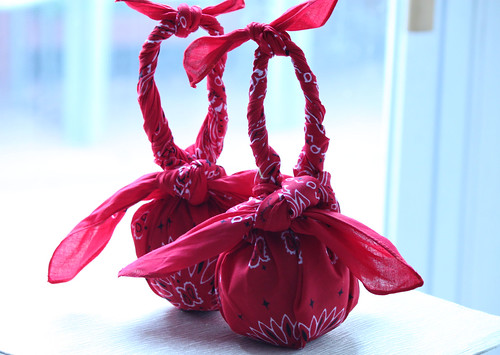Japanese Furoshiki (Cloth Wrapping) Osaka
 More bandana furoshiki, weekend knitter
More bandana furoshiki, weekend knitter
Definition:
Furoshiki is the act of wrapping important items in Japanese cloth. This is seen as a cultural activity and is artistic in its design. Clothes, food, gifts, and other items are wrapped in these decorated clothes. The cloth used for wrapping is referred to as furoshiki.
History:
This cultural activity has ties to the sento or Japanese public baths as far back as the eighth century. Men and women who visited the baths would wrap their clothes in separate bundles. These decorative wrappings started to appear in markets as goods were wrapped using similarly decorated clothes and tying techniques. These clothes were made out of cotton and linen. This evolved into different fabrics and designs, as well as more complex tying techniques. In modern times, the furoshiki cloths can also be found made out of silk, nylon, and other materials. These clothes come in a range of sizes to wrap specific items.
Furoshiki Vocabulary:
Otsukai tsutsumi: Basic carrying wrap in the furoshiki style.
Shibori: Traditional style of dyeing on silk or hemp fabric to make furoshiki cloths.
Furoshiki Wrapping That You Can Do At Home:
1. Gather the cloth you would like to use. A cotton handkerchief or scarf is fine if you don’t have a Japanese furoshiki cloth, but you need to make sure it is in the shape of a square or rectangle. The bigger the square, the easier the folding will be. You can find decorated furoshiki cloth in Asian supermarkets. Alternatively, you can often find traditional furoshiki cloths and designs online such as shibori dyed cloths.
2. Gather the box you would like to cover. It should be rectangular in shape and the size should be around a quarter of the cloth you want to use.3. Have the instructions ready for the furoshiki wrapping design that you wish to fold. I would check out online examples such as http://furoshiki.com/technique_basic_wrap. These steps are going to outline how to fold a basic furoshiki wrap, also known as otsukai tsutsumi.
4. Start with the underside of the cloth facing upwards. Place your box in the center. Note that there are two horizontal corners and two vertical corners.5. Grab one of the vertical corners and wrap it underneath the box.
6. Wrap the last vertical corner on top and wrap it around the box. If there is any excess fabric, fold it over like below.7. Use the horizontal corners as a tie. Your furoshiki wrapping is now finished!
Fun Facts about Furoshiki:
1. There are many furoshiki wrapping styles for a range of items. Some styles with harder techniques include a bag carrying style, bottle wrapping style, flower wrapping style, and different styles for different sizes of boxes.
2. Modern uses of furoshiki have included wrapping gifts, bags for carrying shopping, or as clothing accessories like scarfs, belts or bandanas. Many have used furoshiki as a part of their eco-friendly and minimalist lifestyle. Reasons for this include saving the amount of wrapping paper, as well as limiting the number of items purchased in one shopping trip.3. The popularity of furoshiki has recently risen as people are using personal fabric as reusable carry bags in the furoshiki style. The Japanese Minister of Environment, Mrs. Koike, endorsed the use of furoshiki cloths to minimalize the use of plastic shopping bags in stores in 2006.
4. Mrs. Koike also endorsed a new type of cloth for furoshiki purposes during her time as Minister of Environment. This cloth was made out of recycled plastic bottles and designed in the style of traditional Japanese paintings. This cloth, named mottainai furoshiki, translates to ‘shameful waste cloth’ as it is meant to showcase how trash could be recycled and made into something beautiful.5. The popularity of furoshiki has been idealized in modern Japanese culture as a way to cover and carry lunch boxes. Many Japanese lunches are made in bento boxes, and food in these containers are known for their intricate and careful presentation. The covering is seen as the last personal touch when preparing a bento lunch. The furoshiki cloth that wraps the lunch box is meant to match the color and style of the lunch.
6. Another Japanese custom using furoshiki includes the giving of gifts. A furoshiki cloth should wrap a carefully chosen gift. Gift giving has a long tradition in Japan, which is seen as a social occasion and obligation. Business arrangements in particular should not take place without the exchange of gifts. The gift presentation is even more important than the gift itself, hence the importance of the furoshiki wrapping involved.7. The shibori or traditional style of dyeing furoshiki cloth (mentioned above) dates back to the eighth century. Emperor Shomu gave cloth dyed in the shibori technique as an offering to the Todai-ji Temple in Nara around the same time. The technique to make shibori cloth is similar to tie-dye, as the cloth is twisted in a way to make certain patterns. The traditional color of the dye used is purple.
8. While not exactly furoshiki, another cultural folding craft from Japan is called origami. Similar folding techniques are used to fold paper into a range of shapes. Some origami designs include animals, flowers, or people.9. Japanese wrapping techniques have been used to make a new type of shoe called the ‘Furoshiki’ by Vibram manufacturers. The shoe wraps around the foot and is held together with velcro strips. Their furoshiki shoes are said to be more flexible than other shoes. There are outdoor styles, as well as winter and boot designs.
10. A good online resource if you wish to continue on your own furoshiki journey is found at http://furoshiki.com/techniques/. This is a series of online instructions to help with the techniques and styles you need to wrap cloths in the furoshiki style. There are also a few Youtube videos to assist you as well.







